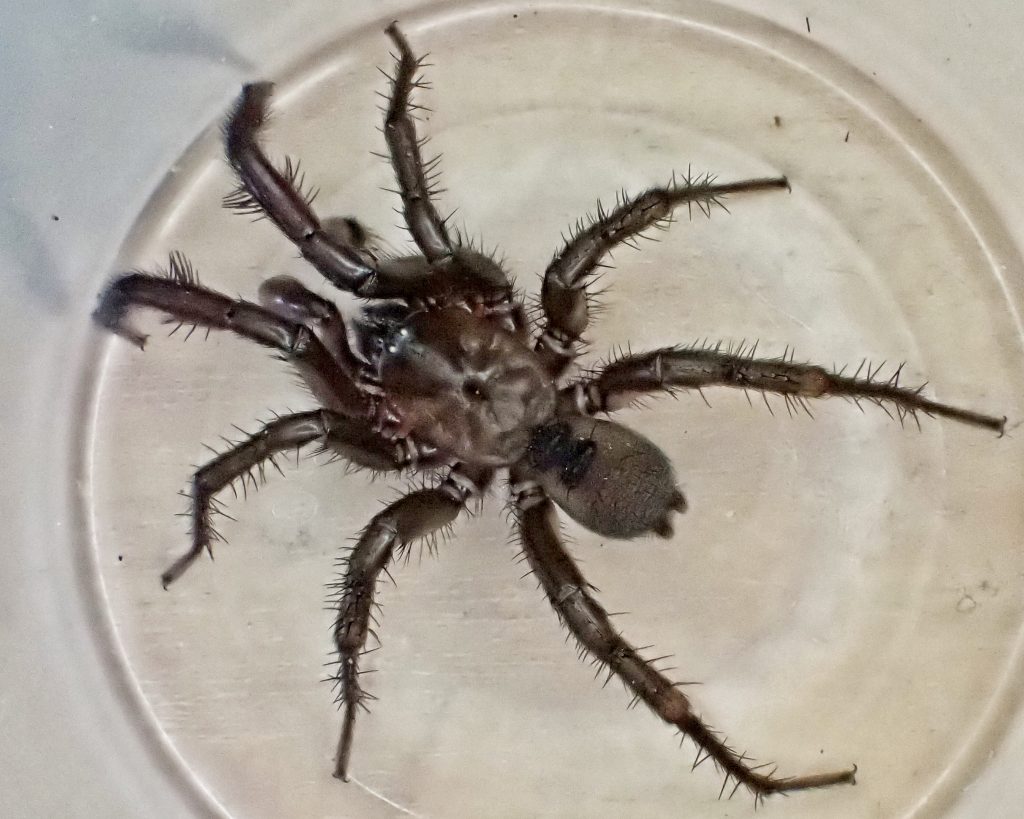
My grandson Lee, who, as I mentioned in A Trip to the confluence of the NF Toutle and Green Rivers, was the one who found the burrows that precipitated this excursion, is going to be very bummed that he wasn’t there for the finding of this Antrodiaetus pugnax folding door spider (ETA- I am going back and replacing all of the places where I said ‘trapdoor’ spider with the correct term ‘folding door’ spider, since Rod Crawford informed me that the term ‘trapdoor spiders’ is only applicable to certain members of the superfamily Avicularoidea, which does not include Antrodiaetus, and ‘folding door spiders’ is the appropriate common name for the members of the family Antrodiaetidae), since he’s been wanting to see one for years. But we’ll be going back and he’ll get his chance. In fact, now that I know that the males are attracted to lights (which is something I doubted until Rod Crawford, who confirmed my identification and was quite helpful in securing information for this profile, told me that at least A. pacificus males are definitely known to come to lights) I’ll be keeping a better eye out for these spiders, since I’ve probably been visited by them and didn’t notice.
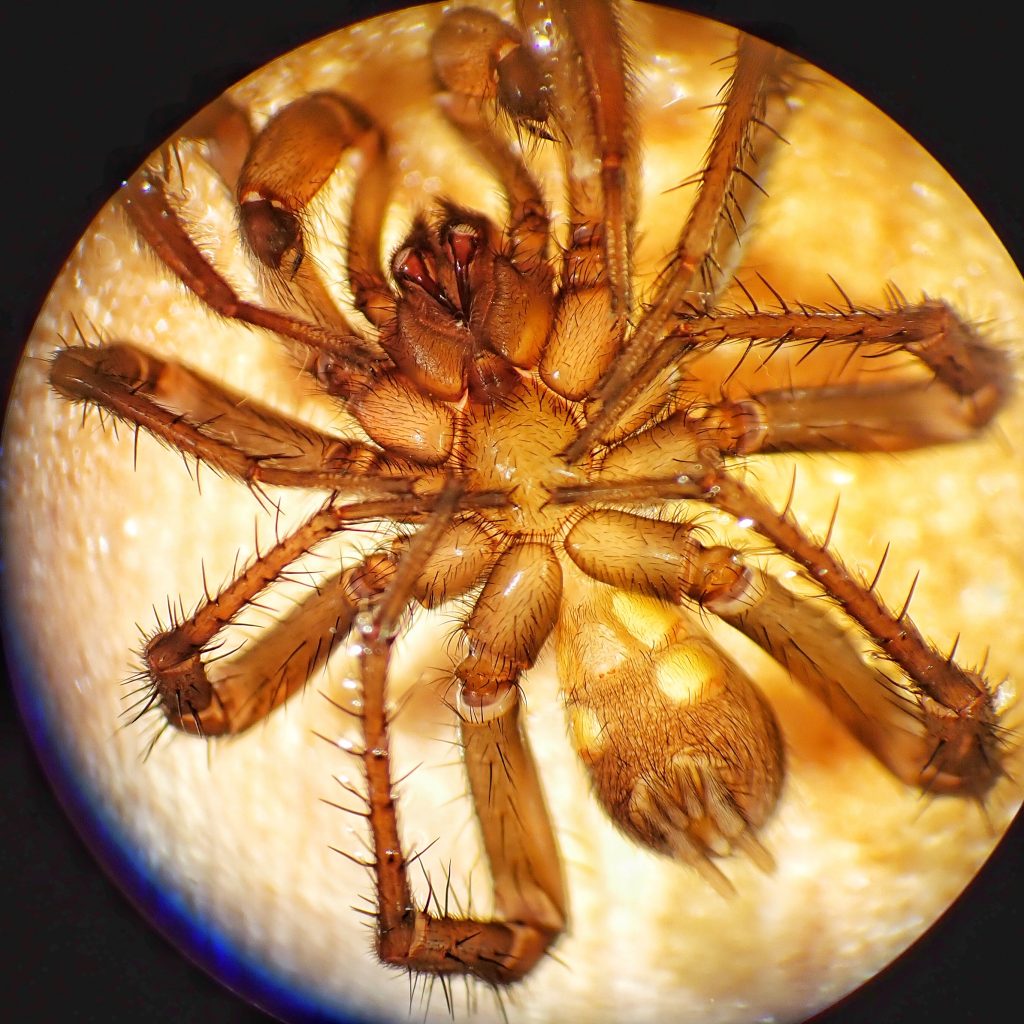
Trapdoor spiders are members of the infraorder Mygalomorphae, which is a more primitive clade (or, more accurately, displays more primitive traits) than the Araneomorphae (which are often called ‘true spiders’, and comprise 93% of all spiders on Earth). The most noticeable difference between the two infraorders is that Mygalomorphs have chelicerae and fangs that are in line with the body, rather than being opposed like pincers. In addition mygalomorphs (which also includes the tarantulas and Australian funnel web spiders) have two pairs of Book_lungs instead of the single pair (or none) found in araneomorphs, and the females may live for many years, rather than dying after they have had a single brood as many true spiders do (ETA-Rod Crawford has informed me that some female araneomorphs, including house spiders and western black widows, may live longer than one year, and that others may produce multiple broods in their one year of life.
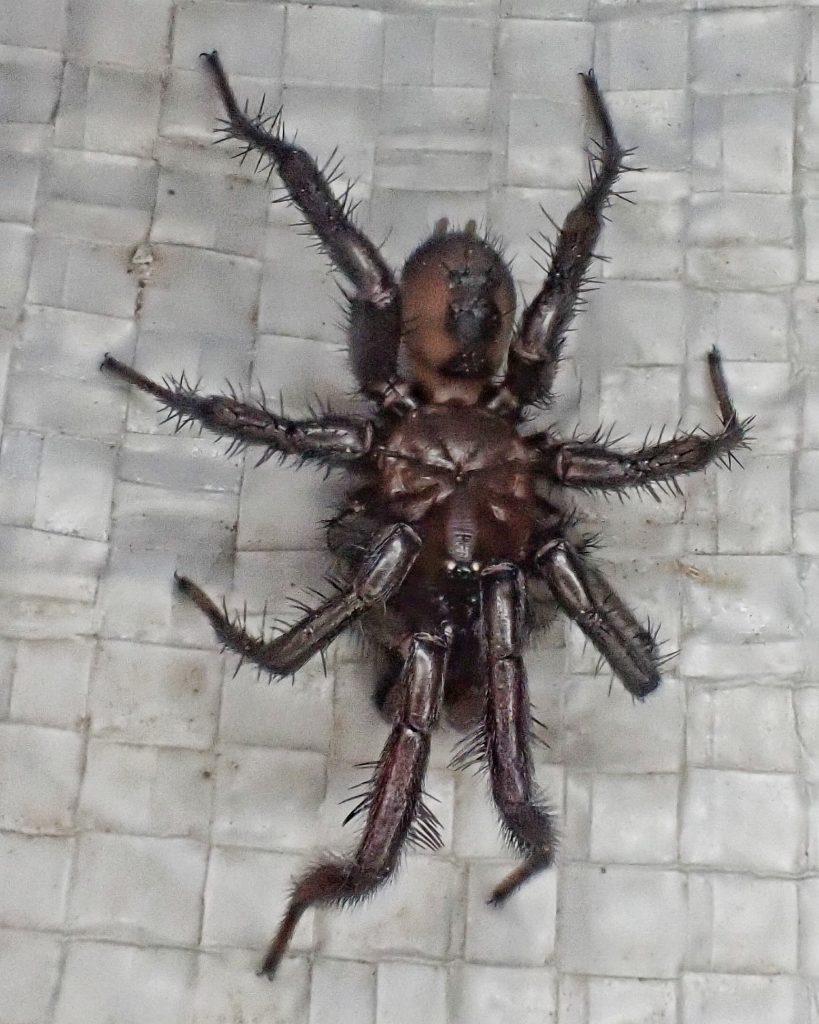
Though I cannot seem to find anything that specifically states this, it seems to me that, with their tendency as a group to live underground and to be primarily nocturnal, mygalomorphs have less resistance to desiccation than araneomorphs. Time and again in my reading for this profile I see references to the humidity needs of these spiders, but I cannot ascertain why this would be, though I do wonder if it comes from moisture loss through the two pairs of book lungs, or merely a need for higher moisture content to absorb oxygen through them, although it may just have to do with the chemical composition of the cuticle covering. If any of my readers have an answer to this I’d appreciate hearing it.
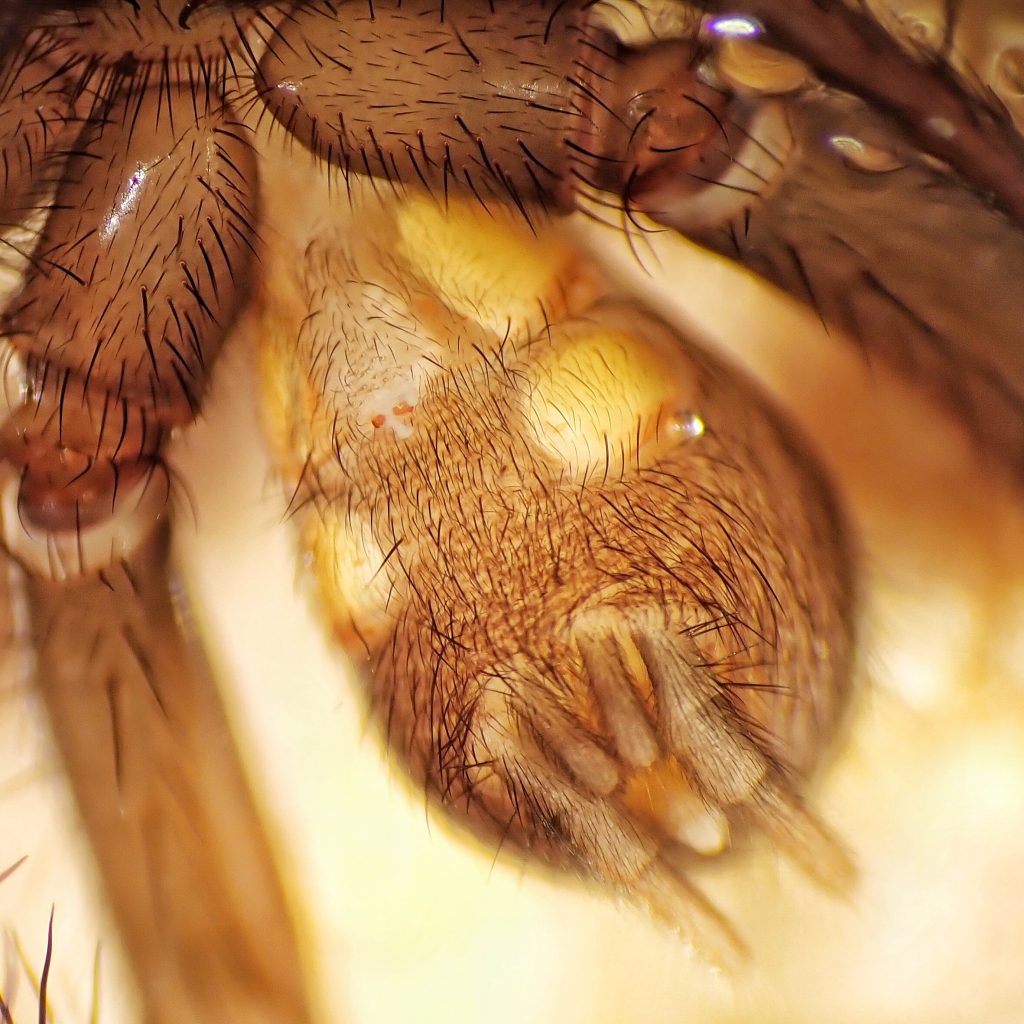
Antrodiaetus pugnax (and folding door spiders in general) are ambush predators who sense the presence of prey via vibrational activation of webs arrayed around the entrance to the burrow. Typically the spider assumes a ‘foraging posture’ near the mouth of an open burrow. Younger spiders can sometimes be found with open burrows during daylight, but more mature spiders usually do not open their burrow except in low light or dark situations, with their attendant higher humidity and greater safety.
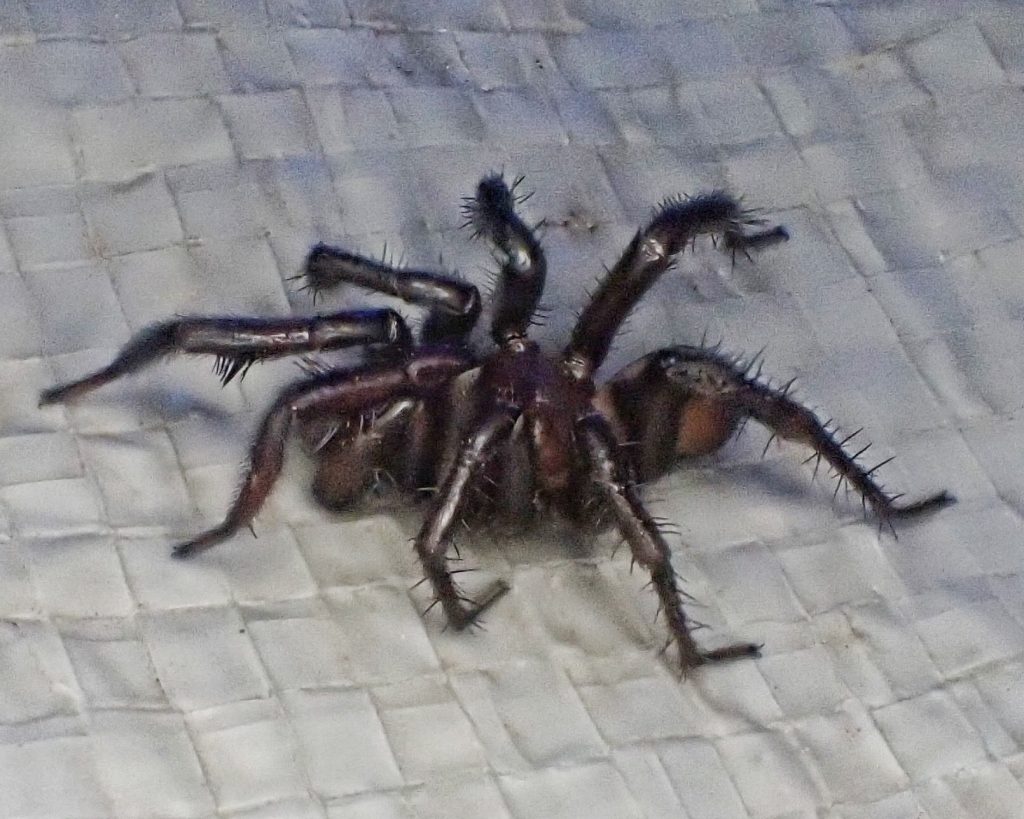
“The burrow is roughly tubular and slightly widened just below the entrance and at the bottom end (Fig. 20). The entire burrow is silk- lined, with the thickest lining in the upper portion. The lining is thicker in burrows with egg sacs, at least in the vicinity of the sac. Burrows vary considerably in size but are usually relatively small (Table 6). The longer burrows were in softer soil. All burrows but one were in horizontal ground; all these were vertical except for a slight turn at the bottom end of some. The burrow pitch of the burrow on sloping ground was 10°. The five penultimate male burrows observed averaged considerably smaller than the female burrows, were completely and rather heavily lined with silk, and had 0-5° burrow pitches. No burrows sloped upward from the entrance…The silk lining of the burrow is extended above the soil surface, stands erect when open, and collapses inward to close off and camouflage the entrance. Soil particles and ground litter fragments are incorporated into this collar. The burrow entrances of older spiders were sealed and plugged with soil (Fig. 20), making it difficult to determine the exact nature of the unsealed entrance. The closure varied from a thin septum of soil and silk only a few millimeters thick to a hard plug up to 15 mm thick, mainly of soil. Such a sealed entrance is very difficult to discover visually. The inside surface of the closure is covered with a lining of silk continuous with the burrow lining.” Frederick Coyle, v.141 (1971) – Bulletin of the Museum of Comparative Zoology at Harvard College – Biodiversity Heritage Library
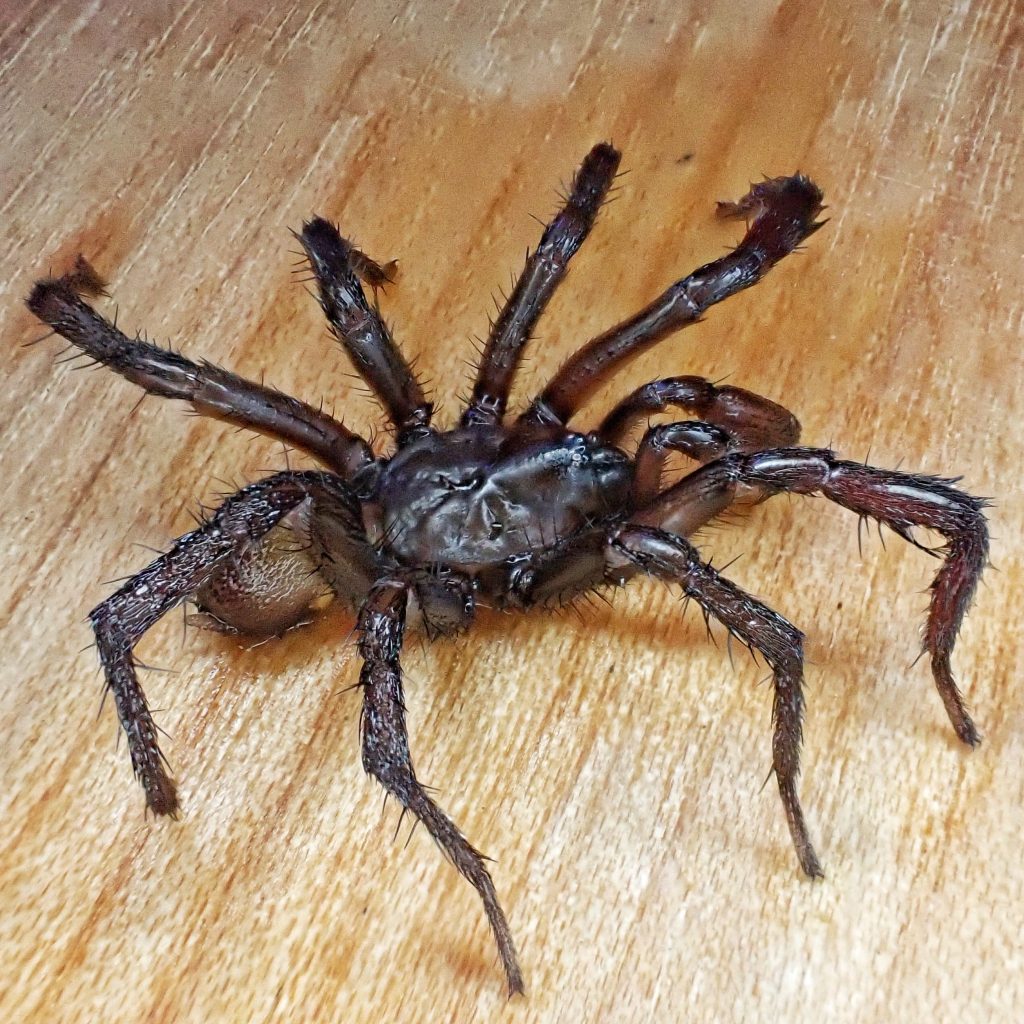
Most of the information in this profile came from a monograph by Frederick Coyle, v.141 (1971) – Bulletin of the Museum of Comparative Zoology at Harvard College – Biodiversity Heritage Library and in many places he says that such and such is ‘similar to A. unicolor’, an eastern species. In those cases I refer to his fairly exhaustive treatment of that species for the information I provide. But even then I’m just hitting the highlights, and anyone with an interest in these spiders is encouraged to read the whole monograph. This paper also has a key to the species of this genus, without which I couldn’t have identified this spider. It was fairly straightforward, once I got over my idea that this spider ‘should’ be Antrodiaetus pacificus.
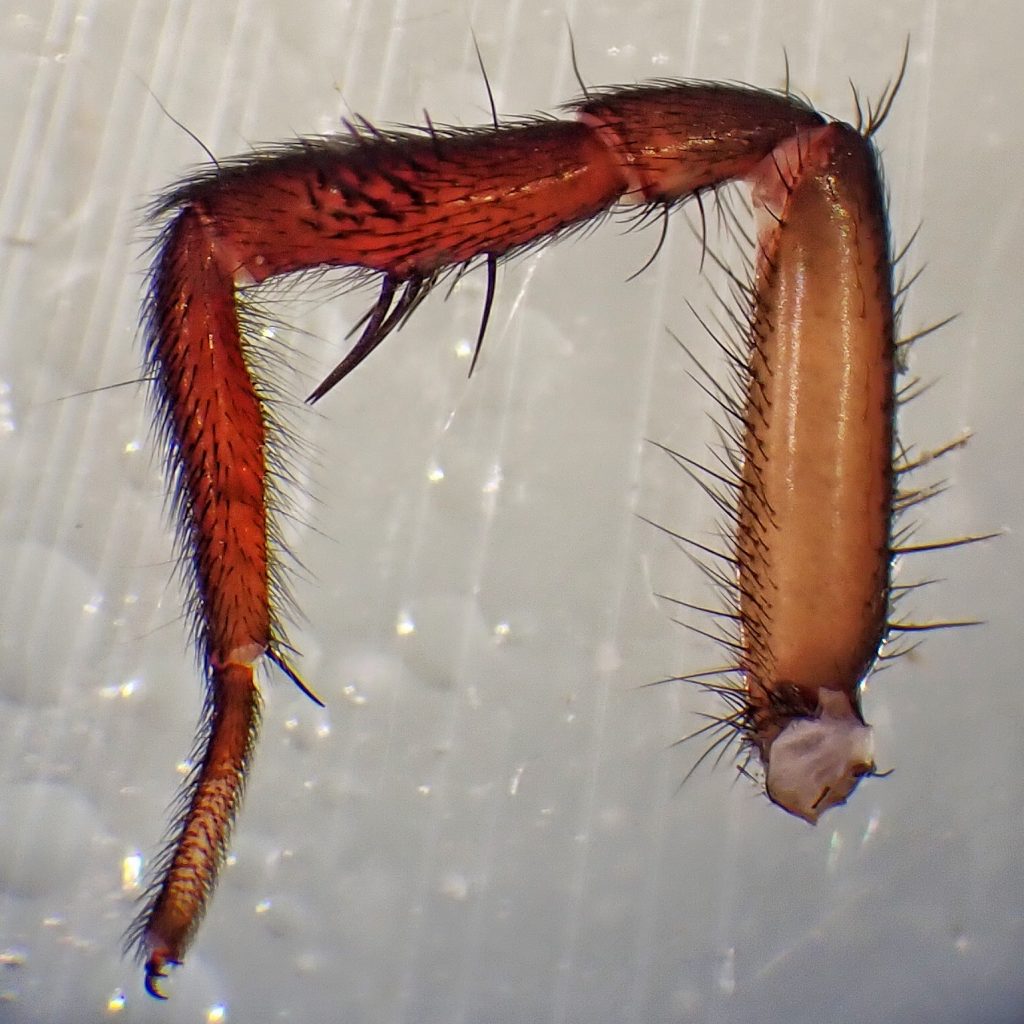
And to those who may be offended by the fact that I euthanized this spider for identification purposes, and have photos of the dead specimen in this profile, I offer a quote by the eminent arachnologist Rod Crawford, from “An annotated checklist of the spiders of Washington” (1988); “Finally, a word to arachnological beginners. If you are new to spider identification, please be aware that to identify even a single spider to species level with reasonable accuracy requires examining genitalia and other tiny body parts with a powerful microscope. Naive persons almost always assume that one identifies spiders by color or “markings” or whole-body appearance, and that the best tool for identification would be a set of photos of entire spider bodies. No such luck! Trying to use whole-body photos for species level identification of spiders, might be compared with trying to construct a computer microchip using a baseball bat. It can’t be done, even by an expert.”
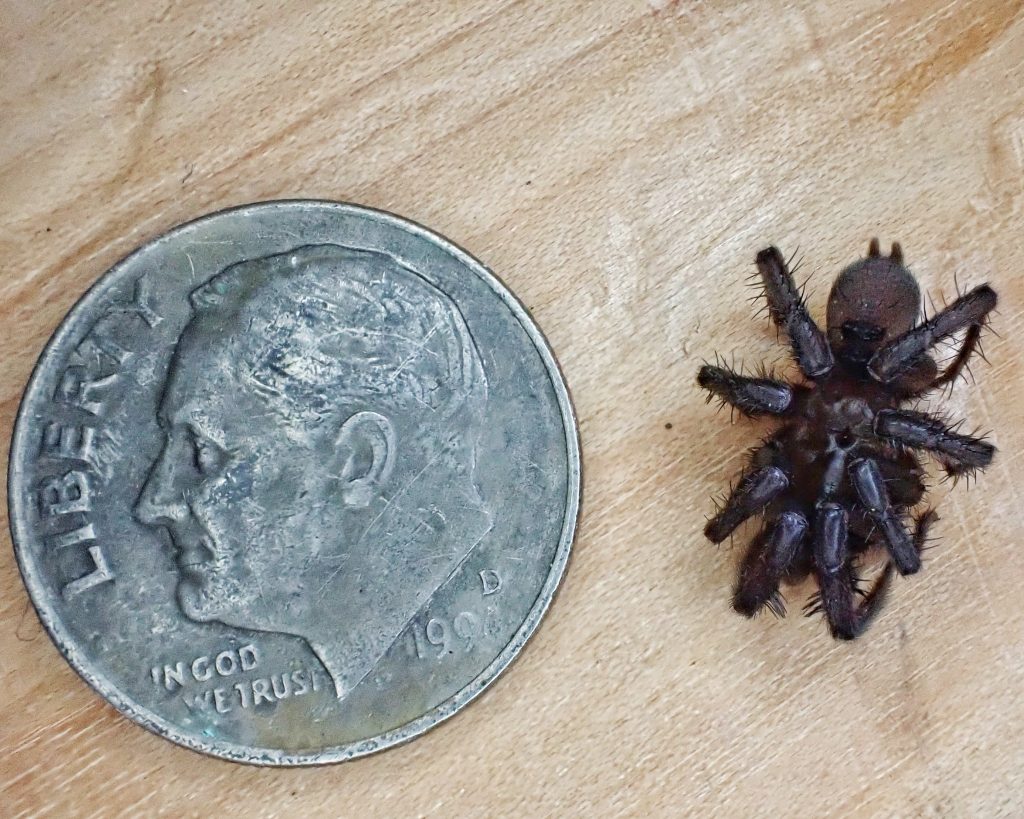
Description– Medium sized (total body length 8-12mm, though females may be bigger, mostly due to the abdominal expansion that comes with breeding) spider with a dark brown carapace that is sunken in the center, a lighter brown abdomen with 2-3 darker sclerites, and stout, dark reddish brown legs with obvious hairs; chelicerae and fangs are in line with the body, rather than opposed as in the true spiders; they have a ventral hump on the tibia (and a smaller one on the metatarsus) with a cluster of large, ensiform (blunt tipped or at least narrowing quickly to a point) macrosetae on the hump.
Similar species– Good optics and a dead or very cooperative specimen, as well as a key, are required to positively identify any of the Antrodiaetus, but if one has those you can tell that other species in our region have most of the macrosetae on the inner part of the first leg attenuated (narrowing very gradually to a point), and have cylindrical tibia and metatarsi.
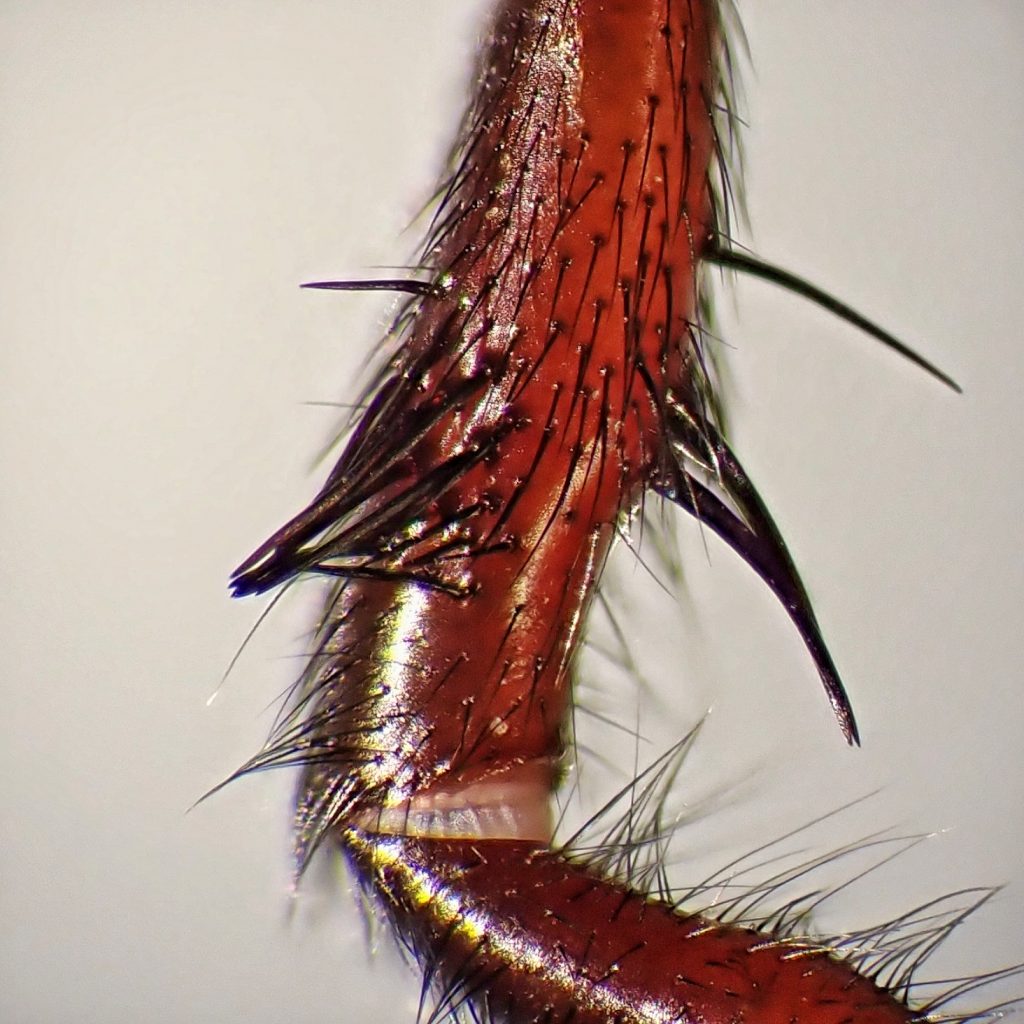
Habitat– Rod Crawford says these are often grassland species, while Coyle found them “located in a deciduous woods with a dense understory of shrubs and herbs along a small, flowing stream. Surrounding the woods was nonforested land, chiefly farmland…[and in] a dense deciduous riparian woods located at the bend of a river and surrounded by wheat fields” v.141 (1971) – Bulletin of the Museum of Comparative Zoology at Harvard College – Biodiversity Heritage Library; the location where I found this one was in a mixed forest above a stream, with a grass and alder flat a couple hundred feet below.
Range– The only range map I could find shows them as being found from the east side of the Coast Range to the west side of the Rockies, and from about 44⁰-48⁰ north latitude, but this could either be much smaller or much larger than reality. ETA-from Rod Crawford- “The distribution of pugnax includes the south-Puget-Sound and Willamette Valley lowlands, plus the Columbia Basin and Palouse grasslands. Contrary to the appearance of a continuous area on Coyle’s map, they have not been found in the mountains (at least up to now; your finding may be about as high in the Cascades as any record I know of).”
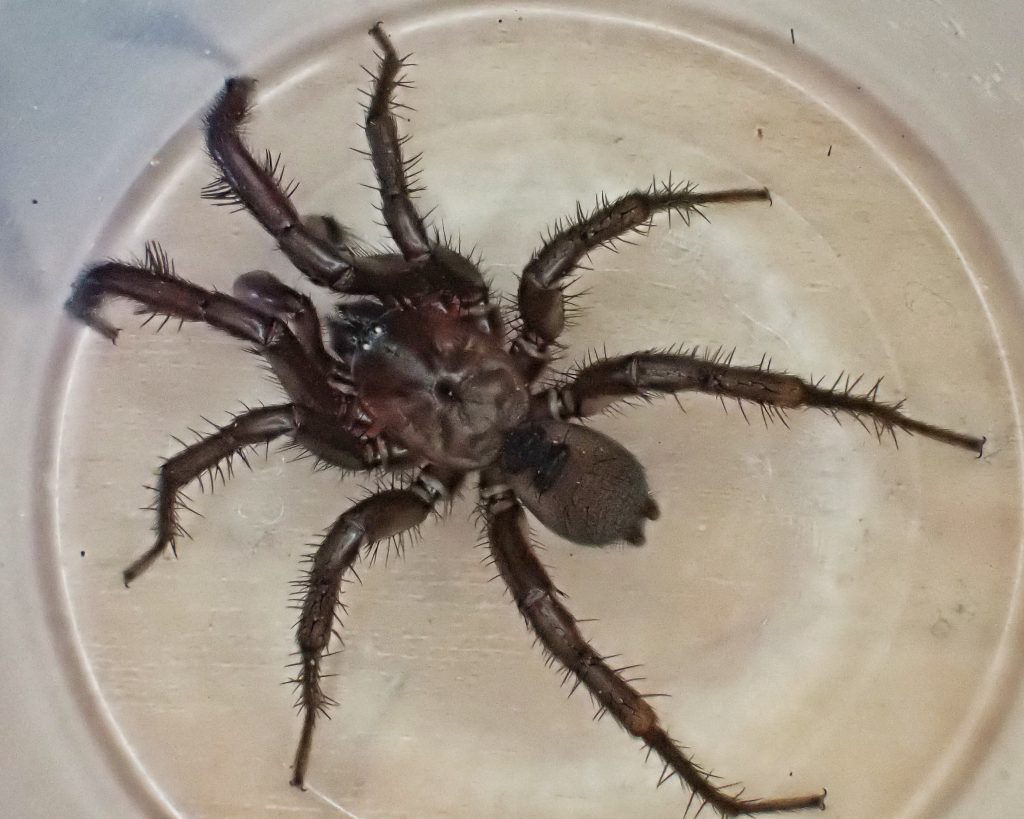
Eats– Anything they can catch and subdue, which turns out to primarily be ants, beetles, and small millipedes.
Eaten by– Probably any insectivore that can catch and subdue them, and apparently toads, frogs, and salamanders are particularly fond of them; parasitized by the larvae of pompilid spider wasps, whose females paralyze the spider and lay eggs in it.
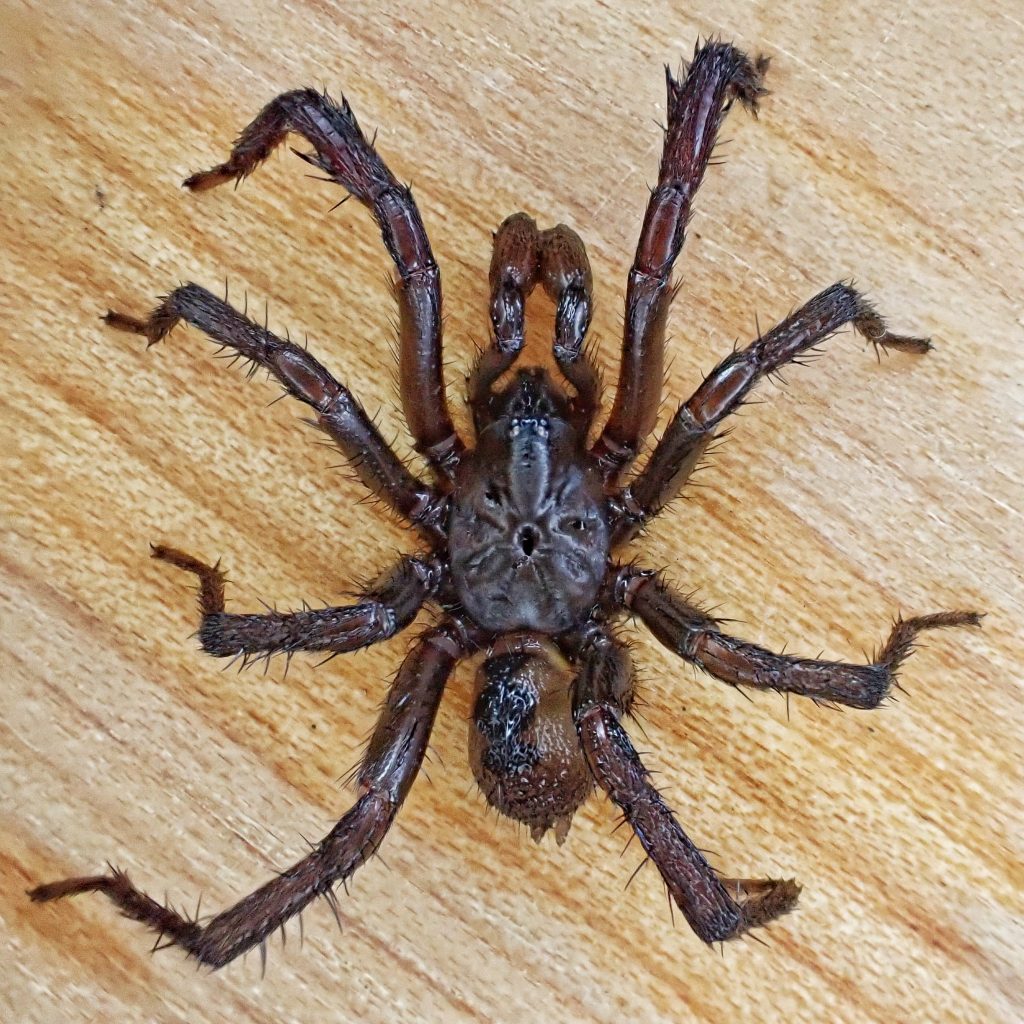
Life cycle– Probably very similar to Antrodiaetus unicolor, which is described here- one brood per year; breeding happens in the fall, and eggs are placed in lens-shaped sacs which are hung from the wall inside the burrow of the mother in the late spring; eggs hatch sometime between June and mid August, first instars last from mid July into September, and second instars go from mid August into December; overwinter as a second instar and remain with the mother in her burrow until the 3rd instar; may take up to 3-4 years to reach sexual maturity; males usually die within a few months of mating; females may live multiple years and produce multiple broods, and appear to continue to molt after breeding.
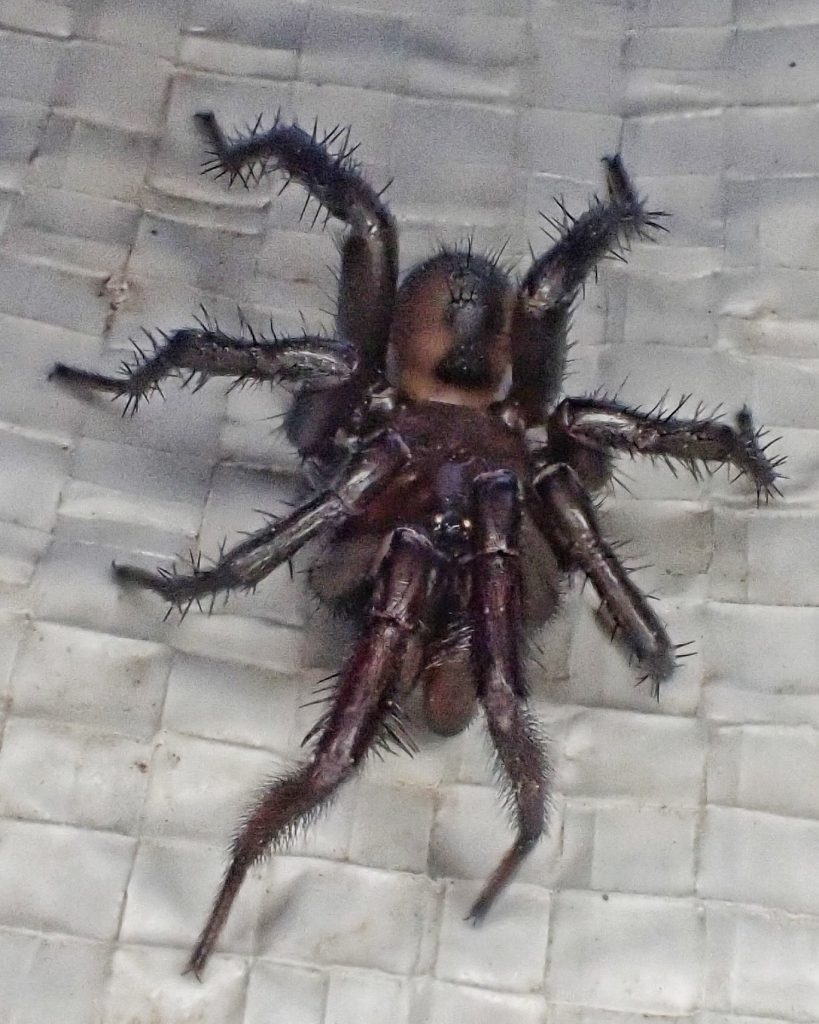
Adults active– Males wander looking for a mate from July possibly into October; females are seldom found away from their burrow.
Etymology of names–Antrodiaetus is from the Greek words for ‘cave dwelling’, which is presumably a reference to them living in burrows. The specific epithet pugnax is from the Latin word for ‘quarrelsome’, and though Chamberlin does explain that he uses pugnax as ‘pugnacious’, he doesn’t say whether he found these spiders to be pugnacious, or merely to look like they would be quarrelsome.
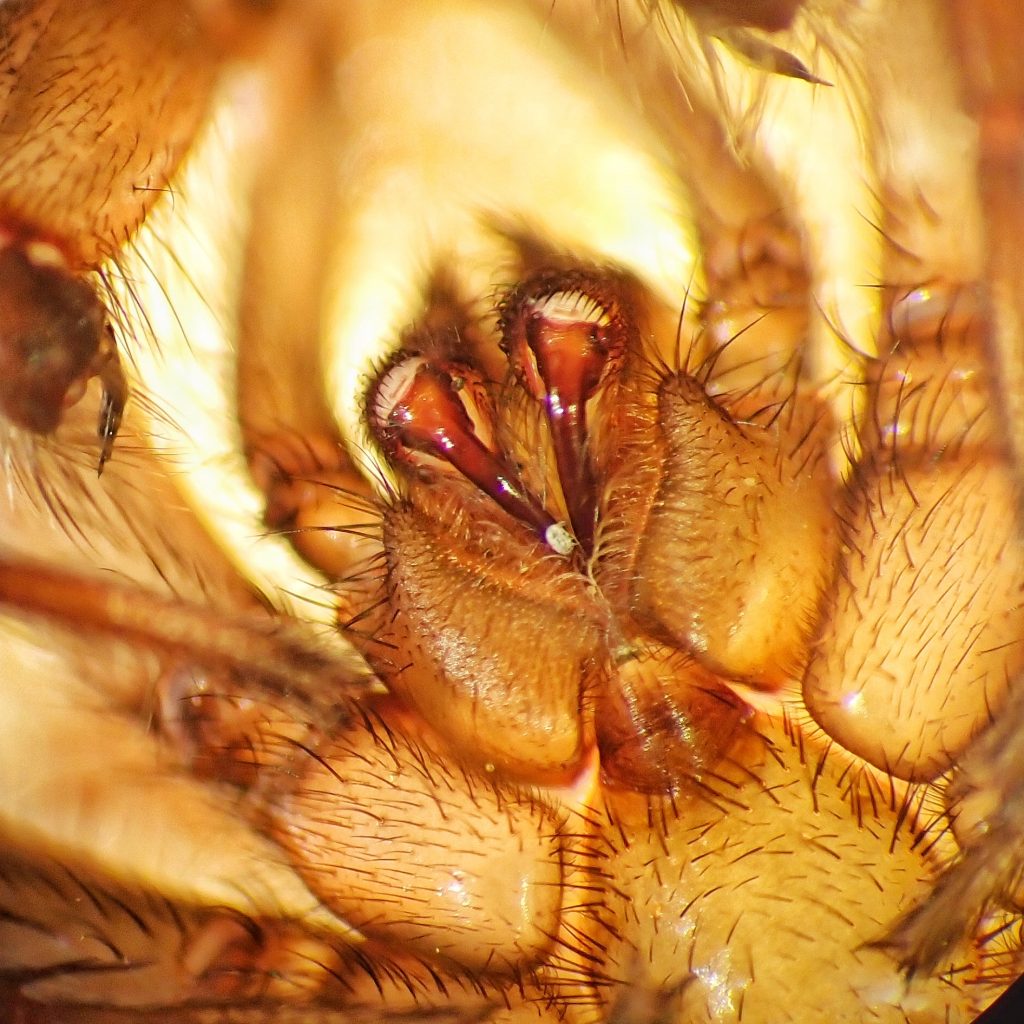
Species Antrodiaetus pugnax – BugGuide.Net
Genus Antrodiaetus – BugGuide.Net
Antrodiaetus pugnax (Chamberlin, 1917)
Antrodiaetus pacificus – The Lurkers of the Pacific Northwest | What the Spiders Taught Me
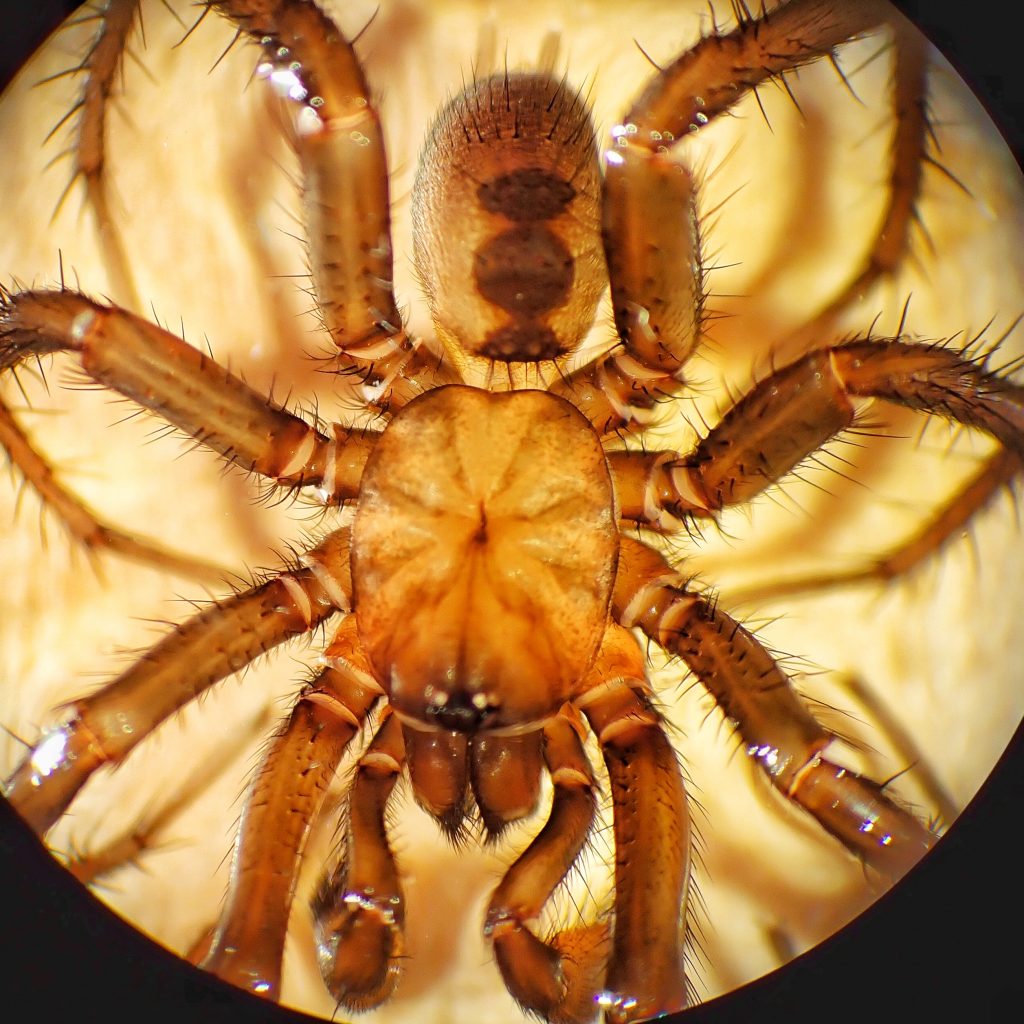
Really appreciate the depth of this profile and all the sleuthing involved. Sheds light on the single Antrodiaetus sp. I’ve found around here. Also near a stream with lots of alder, this one near its mouth to Puget Sound.
Thanks for your appreciation, Chris! Got my spider juices flowing for sure. I actually found another probable A. pugnax today on a gravel trail in Longview, Washington, in broad daylight. Pretty exciting!
Yeah I really wanna find a male of this antrodiaetus genus only pugnax or pacificus cause I live in the northern Willamette valley and I’ve found a juvenile female antrodiaetus pacificus and it’s captivated but I really wanna find a male.
Should be easier to find a male, Ollie, they’re doing a lot of wandering this time of year. I saw another A. pugnax a week ago, just crossing a trail I was on in the middle of the day.